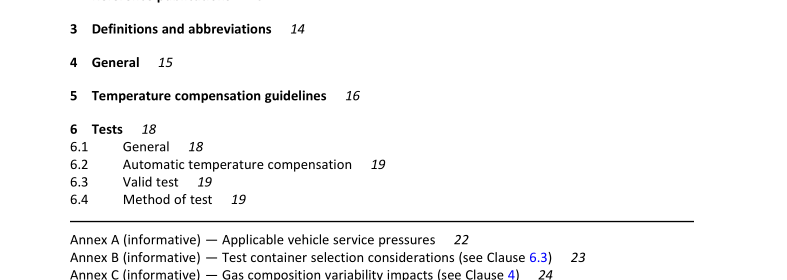CSA NGV 4.3- 2018 pdf download – Temperature compensation guideline for compressed natural gas vehicle fueling.
3 Definitions and abbreviations The following definitions apply in this Standard: Fill pressure — the pressure attained at the actual time of filling. Fill pressure varies according to the gas temperature in the container, which is dependent on the filling parameters and the ambient conditions. Fueling station — a facility for the dispensing of natural gas and includes all stationary equipment and associated components downstream from the inlet of a compressor manual shutoff valve. Full fill — the condition in a container when its settled pressure and temperature are at the levels that will result in the container’s pressure being equal to its service pressure at an internal gas temperature of 21 °C (70 °F). Manufacturer — the person or organization responsible for the design, fabrication, and testing of the equipment and components. Maximum allowable temperature — the maximum temperature for which the manufacturer has designed the equipment (or any part to which the term is referred) when handling the specified fluid at the specified pressure. Maximum allowable working pressure (MAWP) — the maximum pressure to which a component is designed to be subjected when handling the specified fluid at the maximum specified temperature. P30 — 20 700 kPa (3,000 psi), service pressure of. P36 — 24 800 kPa (3,600 psi), service pressure of.
Service pressure — the settled pressure at a uniform gas temperature of 21 °C (70 °F) when the vehicle fuel container is fully charged with gas. This Standard defines standard pressure of 101.325 kPa (14.696 psi) at 288.15 K (15.00 °C, 59.00 °F). Note: The service pressures in common usage are 20 700 kPa (3,000 psi) and 24 800 kPa (3,600 psi) at 21 °C (70 °F). Service temperature range — the temperature range the containers are subjected to in normal service. Settled pressure — the pressure in a container after the temperature of the gas has achieved equilibrium. Standard pressure — defined as 101 325 kPa (14.696 psia) at 15 °C (59 °F) in the United States and Canada. Target pressure — the pressure to which the container is filled to achieve a full fill with consideration for gas temperature inside the tank. Temperature compensation system — any group of components that regulates full fill and/or prevents over-pressurization of vehicle fuel storage containers under operating temperature conditions specified in this Standard.
4 General Temperature compensation — theory (informative) In the United States, station designs and installations are commonly covered by NFPA 52 and vehicle containers are verified under CSA NGV 2. In Canada, station designs and installations are commonly covered by CSA B108 and vehicle containers are verified under CSA B51. Accurate temperature compensation is essential to safety whenever a compressed natural gas vehicle is fueled, regardless of the type of fueling station. Temperature compensation is a feature of the dispenser or fuel delivery system to automatically limit its dispensed pressure based on sensing ambient or natural gas temperature with the goal being to prevent settled pressure in the vehicle container from exceeding 20 700 kPa (3,000 psi) at 21 °C (70 °F) for a P30 vehicle system, or 24 800 kPa (3,600 psi) at 21 °C (70 °F) for a P36 vehicle system, after the temperature of the gas in the container has equilibrated to 21 °C (70 °F). Since most CNG dispensers are typically not able to directly measure or be informed of the gas temperature inside the container(s) being filled, an algorithm within the dispenser control system is typically used to compensate for the temperature rise that occurs (heat of compression) as the gas inside the container is compressed by the fuel flow into the container raising the pressure, and hence, density of the gas as well. Additionally, the temperature of the gas in the container may increase after fueling if the temperature of the environment increases before fuel from the container is used and pressure is reduced, which may occur with warming outdoor temperatures or when moving a vehicle indoors.CSA NGV 4.3- 2018 pdf download
